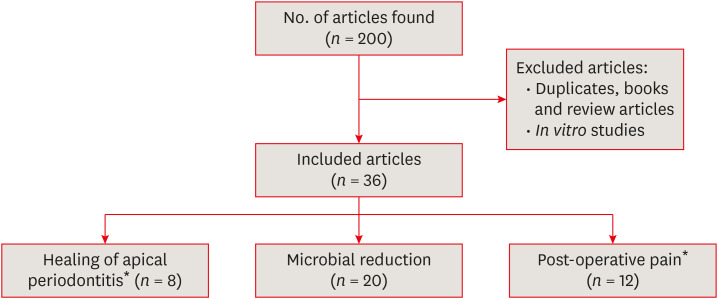-
Clinical efficacy of activated irrigation in endodontics: a focused review
-
Amelia Wan Tin Cheung, Angeline Hui Cheng Lee, Gary Shun Pan Cheung
-
Restor Dent Endod 2021;46(1):e10. Published online January 26, 2021
-
DOI: https://doi.org/10.5395/rde.2021.46.e10
-
-
 Abstract Abstract
 PDF PDF PubReader PubReader ePub ePub
Root canal debridement, which includes the removal of infected tissues and microbial biofilms, is considered the corner stone of root canal treatment. Chemical adjuncts play a multitude of functions in this regard, as tissue solvents, antimicrobial agents and for removing the smear layer. These adjuncts (irrigants) are usually delivered using a syringe and needle. With increasing knowledge of the complexity of root canal anatomy and tenacity of microbial biofilms, the need for strategies that potentiate the action of these irrigants within the root canal system cannot be overemphasized. Several such activated irrigation strategies exist. The aim of this review is to comprehensively discuss the different irrigant activation methods from the context of clinical studies. -
Citations
Citations to this article as recorded by  - REVOLUCIONANDO LA ENDODONCIA: LA IMPORTANCIA DE IRRIGANTES MÚLTIPLES PARA UNA DESINFECCIÓN EFECTIVA DEL SISTEMA DE CONDUCTOS RADICULARES UNA REVISIÓN NARRATIVA
Irving Pablo Fernandez Calle, Edwin Macias Limachi , Abigail Marisol Vargas Ticona , Jenny Paula Aguilar Avalos , Marivel Irene Condori Escobar, Alcides Ramber Maldonado Huaycho , Jenny Claudia Apaza Cayo , Miguel Angel Espinoza Vega , Jesús Alejan
RECIMA21 - Revista Científica Multidisciplinar - ISSN 2675-6218.2024; 5(11): e5115929. CrossRef - Cleaning and disinfection of the root canal system provided by four active supplementary irrigation methods
Alessandra Timponi Goes Cruz, Adriane Antoniw Klemz, Edvaldo Antônio Ribeiro Rosa, Fabiana Soares Grecca, Bianca Mattos, Lucila Piasecki, Ricardo Machado, Sérgio Aparecido Ignácio, Ulisses Xavier da Silva Neto
Scientific Reports.2024;[Epub] CrossRef - Postendodontic Pain Using Single File System with Different Irrigation Protocols in Single-visit Root Canal Treatment: A Randomized Control Trial
Kiran Patel, Kailash Attur, Nishtha Patel, Kamal M Bagda, Karthik P Venkataraghavan, Mohammed B Mustafa, Shylaja K Attur
The Journal of Contemporary Dental Practice.2024; 25(2): 180. CrossRef - Bacteria debridement efficacy of two sonic root canal irrigant activation systems
Chang Zeng, Pei Hu, Colin P. Egan, Brian E. Bergeron, Franklin Tay, Jingzhi Ma
Journal of Dentistry.2024; 140: 104770. CrossRef - Evaluation of different activated irrigation protocols on debridement quality in various access cavity designs
Urvashi M. Ujariya, Mitul Lallubhai Gangani, Rajendra P. Bharatiya, Anjali K. Kothari
Endodontology.2024; 36(4): 400. CrossRef - Synergistic antimicrobial potential of EGCG and fosfomycin against biofilms associated with endodontic infections
Cristiane DUQUE, Amanda Caselato Andolfatto SOUZA, Kelly Limi AIDA, Jesse Augusto PEREIRA, Karina Sampaio CAIAFFA, Vanessa Rodrigues dos SANTOS, Leopoldo COSME-SILVA, Anuradha PRAKKI
Journal of Applied Oral Science.2023;[Epub] CrossRef - Insights of fluid dynamics in an optimally shaped root canal system
Kavalipurapu Venkata Teja, Sindhu Ramesh, Krishnamachari Janani
Saudi Endodontic Journal.2023; 13(2): 216. CrossRef - Diamond–coated ultrasonic tip decreases debris and uninstrumented surface after preparation of curved canals with isthmus
Maria Luiza GIOSTER–RAMOS, Mariana Mena Barreto PIVOTO–JOÃO, Jáder Camilo PINTO, Juliane Maria GUERREIRO–TANOMARU, Mário TANOMARU–FILHO
Brazilian Oral Research.2023;[Epub] CrossRef - Effectiveness of Passive Ultrasonic Irrigation Protocols in Simulated Complex Root Canal Cavities
Flávia A. Plazza, Renan Dal-Fabbro, Leopoldo Cosme-Silva, Paulo C. T. Duarte, Caroline Loureiro, Vitória Z. Custódio, Luciano T. A. Cintra, Marco A. H. Duarte, João Eduardo Gomes-Filho
Oral.2022; 3(1): 1. CrossRef - Comparison of sealer penetration of sonic activation versus conventional needle irrigation: a systematic review and meta-analysis of randomized controlled trials
Li Tan, Qiong Liu, Yun Chen, Ya-Qiong Zhao, Jie Zhao, Marie Aimee Dusenge, Yao Feng, Qin Ye, Jing Hu, Ze-Yue Ou-Yang, Ying-Hui Zhou, Yue Guo, Yun-Zhi Feng
BMC Oral Health.2022;[Epub] CrossRef - Efficacy of Photoinduced Photoacoustic Streaming and Diode Laser Irrigation Techniques on Smear Layer Removal, Sealer Penetration and Push-out Bond Strength
Latifa Mohamed Abdelgawad, Nancy Attia Ahmed ElShafei, Somaia Abdlatif Eissa, Dalia Yahia Ibrahim
Journal of Lasers in Medical Sciences.2022; 13(1): e12. CrossRef - Microbiological Aspects of Root Canal Infections and Disinfection Strategies: An Update Review on the Current Knowledge and Challenges
Jasmine Wong, Daniel Manoil, Peggy Näsman, Georgios N. Belibasakis, Prasanna Neelakantan
Frontiers in Oral Health.2021;[Epub] CrossRef - In vitro evaluation of efficacy of two endodontic sonic-powered irrigant agitation systems in killing single-species intracanal biofilms
Chang Zeng, Joseph Everett, Stephanie Sidow, Brian E. Bergeron, Fucong Tian, Jingzhi Ma, Franklin R. Tay
Journal of Dentistry.2021; 115: 103859. CrossRef - A novel three‐dimensionally printed model to assess biofilm removal by ultrasonically activated irrigation
Min‐Ji Choi, Mi‐Ah Kim, Yoorina Choi, Prasanna Neelakantan, Mi‐Kyung Yu, Kyung‐San Min
International Endodontic Journal.2021; 54(10): 1871. CrossRef
-
477
View
-
24
Download
-
14
Web of Science
-
14
Crossref
|




